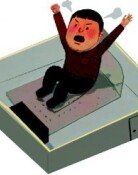Chusa's beauty of maturity awoke from sleep in 165 years
Chusa's beauty of maturity awoke from sleep in 165 years
Posted February. 27, 2017 07:10,
Updated February. 27, 2017 07:22

Among the documents and paintings was Noseolcheop, a memorandum in which Kim Jeong-hui wrote his poems Seoknosi, and Yeongbaekseoljo with semi cursive style of writing in 1852 while he was stayed in Gwacheon after exile in Bukcheong, Hagyeong Province. Park Cheol-sang (50), a text researcher of Chusa, said, “His writing style in the work is matured at his later age and the fact that he elaborately wrote poems along with lines is understood that he made the book as a gift.”
Researchers have found many documents this time at Kyoto University and most of them was thought not to exist or were existed in the list. For instance, 11 books of Gyeongse Yupyo Gajangbon, flagship works of Dasan Jeong Yak-yong (1762-1836) which were not in the list, have been discovered in a dusty-ridden box. “Footnotes at the top of documents are regarded to be written by his students or ancestors at least," said Kim Bo-reum, who received a doctorate at the Academy of Korean Studies for her study of collected writings of Dasan. "Considering the contents of documents, they were made earlier than other Gajangbon.” It is considered that the books found this time were not referenced when Shinjoseonsa issued the complete collection of Dasan in 1936.
The story of Geumseokjibcheob that was compiled by Kim Jae-ro, prime minister under King Yeongjo of the Joseon Dynasty, by taking rubbings of stone inscription of epitaphs across the nation was fully disclosed. Geumseokjibcheob that was discovered this time was composed of 219 books in total and contain more than 2,000 rubbings as well as many epigraphs that were mostly disappeared or of its contents were not identified due to damages. Thirty-nine books of Geumseokjibcheob by Kim Jae-ro are currently housed in Gyujanggak Institute for Korean Studies at Seoul National University and only their existence was known from previous investigation of Kyoto University by the National Institute of Korean History.
A Scroll of Myobeopyeonhwagyeong that was assumed to be made in the early Joseon Dynasty was also found. All four volumes of Myobeopyeonhwagyeong made in the Goryeo Dynasty are designated as treasures.
Some 5,000 commercial documents including documents describing price policy of Hanseongbu (center of politics and economy during the Daehan Empire) and materials of Seonhyecheong (public procurement service) were also found and they were deemed valuable to fill the blank of economic history study of the Joseon Dynasty. “It is the first time that valuable copies of documents as well as writings and paintings are found in volume" said Jeong Woo-bong, Korean language professor and director of the Center for Overseas Resources on Korean Studies at Korea University. "They will be main subjects for Korean Studies for the next several decades.”
Jong-Yeob JO jjj@donga.com







